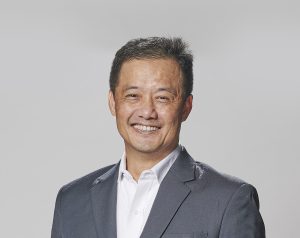Last December, Alliance’s Tokyo-based East Asia Representative, Fan Li, had a chance to sit down with the CEO of Temasek Foundation, Ng Boon Heong at the Asia Philanthropy Congress 2023. Boon Heong talked about how the foundation was built upon the same principles and value propositions that make Singapore successful, and its strategy of deploying philanthropic capital to pilot innovations and proactively partnering with outcome partners to scale for impact.
Fan Li: What is the origin of Temasek Foundation, and what is the relationship between the foundation, Temasek, and also the Singapore government?
Ng Boon Heong: Temasek Foundation is birthed out of a desire to do good and help our neighbours and Asia prosper. Temasek Foundation benefits from philanthropic gifts of Temasek, a global investment company headquartered in Singapore. Temasek’s sole shareholder is the Singapore Minister of Finance, as a body corporate under the Singapore Minister for Finance (Incorporation) Act 1959 and her current portfolio value is 382 billion Singapore dollars as at 31 March 2023.
Temasek operates independently, on a commercial basis, with its board of directors and a professional management team. The Singapore government does not interfere in Temasek’s decision-making processes as an investment company or Temasek Foundation as a philanthropic body.
The Temasek charter outlines three roles; an active investor, a forward-looking institution, and a trusted steward. As a trusted steward, Temasek implemented a philanthropy policy in 2003, dedicating a portion of its net positive returns exceeding the risk-adjusted cost of capital to a community fund. Temasek Trust was established in 2007 with a 500 million Singapore dollar endowment, reflecting the organisation’s long-term perspective. Temasek Foundation was also established in the same year.
FL: Apart from the continued financial support, does anyone from the company sit on the board of the foundation?
NBH: No. The financial support is based on broad mandates through endowments supporting causes such as sustainability, culture, sports and education.
Temasek Foundation is governed by an independent board of directors and committee members comprising of distinguished persons, including non-Singaporeans.
‘Healthcare and education have been our core programmes since the very beginning. Good healthcare and education outcomes are vital to the success of Singapore and much needed in the world, so these areas have become very important for us to work in’
FL: Temasek Foundation has set up a number of endowments named after the figures who were important in the development of Singapore after independence. Does this reflect a determination to build on the principles that guided those early years?
NBH: Our endowments can be broadly grouped into those named after the pioneer generation leaders such as S Rajaratnam Endowment, as well as those without such names. All have broad mandates supporting various causes.
We believe it is important to honour the pioneer generation leaders. So we are very deliberate in making sure that we choose people with principles and values worth emulating when naming endowments. We hope through these endowments, we can curate programmes to pass on the principles and values of these pioneers to the next generation.
FL: The Foundation operates across a wide range of areas – social welfare, culture, healthcare, scientific innovation – how did these areas emerge?
NBH: Our focus areas originated from observing Singapore’s success and a desire to share that success regionally; and we can all grow together. For example, healthcare and education have been our core programmes since the very beginning. Good healthcare and education outcomes are vital to the success of Singapore and much needed in the world, so these areas have become very important for us to work in.
Having good governance and good leaders are equally essential, leading to programmes for young leaders. Over the last five years, the topics of sustainability and climate change have emerged. So now sustainability and climate change have become an important pillar of the programming that we do. These are the broad categories of our programmes.
FL: So you started by identifying these priority areas. Do you assess whether these areas remain the right direction to continue going on?
NBH: We do and review regularly to see how we can shift funding and capital where it’s needed most. We also looking at where are the greatest opportunities for impact are. Our approach is to look for opportunities to catalyse WOW successes. It usually involves deploying capital to pilot innovations and proactively partnering with outcome partners to scale the impact for the benefits of the wider community. The endowment model is also a very useful and important one, as it allows us to develop strategies and plans over a longer time horizon without having to worry about funding availability on a year-by-year basis.
FL: How much does the Foundation give each year?
NBH: Last year (2022), it’s above 60 million Singapore dollars. This year we are trending higher, towards 80 to 90 million.
FL: Was the increase from last year (2022) related to COVID-19? How did the pandemic affect your work?
NBH: The pandemic was an unprecedented once-in-a-lifetime crisis for the world, prompting us to redirect resources earmarked for various purposes. In fact, we had already been allocating capital towards infectious disease for many years, since good health and well-being is part of our mandates. The COVID-19 pandemic accelerated our efforts in this direction.
FL: What do you consider your flagship programme?
NBH: Two programmes we are quite proud of. First is our global climate tech competition named ‘The Liveability Challenge’, which crowdsources deep tech solutions globally. One of our past winners, Equatic, was recently showcased at COP28 last year. The second programme is called O.S.C.A.R: O for ownership, S for sustainability, C for cares, A for assurance, and R for resilience, which provides micro-financing to ground-up initiatives, so that they can connect the last mile and directly support communities in need. Amid the pandemic, we established an OSCAR fund in Singapore and it is catalysing a culture of giving and doing good, by everyone in society.
FL: Apart from funding, is the foundation also involved in programme development?
NBH: Yes. We do three things: we provide grants, we co-curate solutions and partnerships, to accelerate solutions, and we also connect them with potential outcome funding.
An example is Equatic, a US-based company that has invented a method to remove gigatonnes of CO2 from the atmosphere via the oceans by electrolysing sea water. The company won a million Singapore dollars at The Liveability Challenge, so they can build their first proof of value prototype. Suppose you can extract carbon dioxide from sea water. In that case, the ocean can then absorb more carbon dioxide from the atmosphere, and there are so many desalination plants across the world that you can deploy this technology. Through The Liveability challenge, we have been able to bring in deep tech, cutting-edge solutions such as Equatic to scale.
FL: Singapore has a style of government that takes care of its people. How does this fit in with the foundation’s work? Do you see yourselves as complementing state provisions or doing what the government can’t or won’t do?
‘What differentiates us is that I think our role is complementary to both the government and the private sector. But our risk appetite is higher. Without calculated risk taking and innovations, you cannot find the next breakthrough solution and the next black diamond unicorn.’
NBH: We take good governance seriously. We see ourselves as responsible stewards of assets and resources, and we treat the financial resources very seriously. What differentiates us is that I think our role is complementary to both the government and the private sector. But our risk appetite is higher. Without calculated risk taking and innovations, you cannot find the next breakthrough solution and the next black diamond unicorn.
FL: You attended Asia Philanthropy Congress last year and you were also one of the speakers at Philanthropy for Better Cities Forum in Hong Kong this September, hosted by the Hong Kong Jockey Club Trust. Then there is Philanthropy Asia Summit launched by Temasek Trust. How do you see the value of these events to bring region’s philanthropic leaders together on a regular basis?
NBH: I have attended all three events. I see the way they are run and their focus, there are overlaps but there are also differences. I think a degree of overlaps is healthy. These platforms allow people to cross-learn and provides repeat opportunities to discuss practical and tangible ways to collaborate. Collaboration needs time and you need to build trust in personal relationships. Events like these are very important, especially considering the cultural diversity in Asia, where needs, environments, and opportunities are also quite different.
Fan Li is the East Asia representative for Alliance







Comments (0)